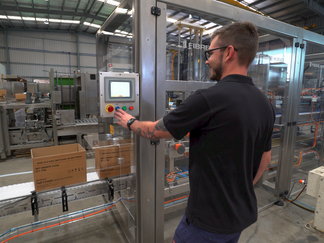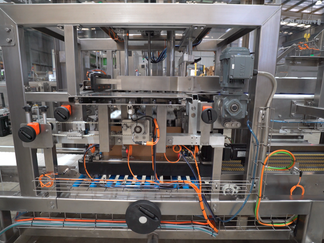Jake Bichel from Fibre King stands by his Custom Case Packing Design.
- christinawindsor
- Jun 23, 2022
- 4 min read

Jake Bichel, our Mechanical Engineer (Honours) stands by his custom case packing design. This case packing solution called for something a little different than the traditional all in one case erector, packer and sealer. The customers parameters for their new case packing, weighing and labelling line meant that the case packer had to exceed the filler rate and pack 100 products per minute for two different case formats and product variants as well as fit into their compact facility. Furthermore, it was also required that the system would integrate a check weigh machine, label applicator, and barcode scanner prior to a spiral conveyor to transport the cases to a lower level. As well as this, the customer also specified utilising a Lantech case erector and case sealer to the line. This required an integration of 6 different external machines whilst meeting the speed and customer layout requirements.
Design Considerations
To integrate all external machines and adhere to the customer’s factory layout, a counter flow design was selected. This allows boxes to be erected and transported to the load station, whilst the product from the filler can accumulate from the opposite direction. This minimised the footprint of the entire machine while maneuvering around factory pillars and walls. Once the product is loaded, it is then transported to a tape sealer before checking the carton weight. If the carton weight is correct, a label will be applied and a scanner checks the label is applied correctly and is readable. Two reject stations are placed in this area. One is used to reject cases that do not meet the weight range and the second is for rejecting a carton with an incorrect barcode scan. Moreover, a function is programmed on the HMI that allows the operator to reject a carton after “x” number of counts for quality control purposes.
“Aside from the uniqueness of the layout and integration requirements, the case packer itself has impressive features.” Says Jake. “As the product arrives at the packer single file, a servo diverter is used to clamp the product before switching and releasing a slug down the desired lane. Once the product has been diverted from single file to multiple lanes, it then arrives at a set of pins used to index a case. A case of product is then indexed and transported over a set of stripper plates to the loader. The loader will then gain vacuum and stripper plates will open. Meanwhile, cartons are erected and indexed from the opposite direction using a series of side drive belts and flap guides to get into position. Once the loader and case placement are satisfied, product will be loaded and the case will be ejected to be sealed.” He adds.
All aspects of the machine functionality are considered in design, including the changeover procedure. The changeover procedure involves using a set of handles with counter values to adjust to different case sizes. The loader utilises a quick-release pneumatic fitting and a quick-release mechanical fitting to swap out the loader head with ease. The infeed conveyor is then comprised of a series of kipp handles used to exchange all other change parts. This allows for an efficient change over procedure of less than 5 minutes for an operator to minimise downtime.
“RSC case packers are designed around customer requirements. Every customer will differ in product type, filler rate, factory layout, case formation, and case sizing. This case packer, however, differs from the standard RSC top load design in several ways. Initially, this machine has an integrated erector and sealer, independent of the load cycle. Secondly, the standard design will incorporate a parallel flow infeed where boxes and product are transported in the same direction, rather than the counter flow operation in this machine. Furthermore, the standard design will often have a complex load cycle that needs to travel in two directions, whereas, this load cycle is simplified to pick and place in one direction only.” Says Jake.

Fibre King tailors’ machinery to meet customer requirements. “To integrate with external machines, it is crucial that the interfacing is correct.” Says Jake. “To interface correctly, Fibre King will communicate with the external suppliers to receive a 3D copy of their machine to incorporate into the model. This 3D model will enable accuracy in design of the interface. Following on from this, Fibre King will then ensure that the model fits within the confines of the factory layout by producing a 2D drawing and overlaying it with the customer’s factory. The customer is then informed of any changes to the layout and will confirm the design/footprint prior to manufacturing.” He adds.
Well Done Jake!
Jake has been with Fibre King for just under 2 years and with the guidance of the senior team was able to design the case packer to fit Fibre Kings high standards that combine practical design, robust manufacturing and simple operation providing customers with a thoroughly reliable machine. “We are thrilled to have Jake as part of our team, he has an excellent understanding of mechanical design and application. We are excited to see his skills evolve as he takes on new challenging designs.” Says James Windsor, CEO of Fibre King.




































































Comments